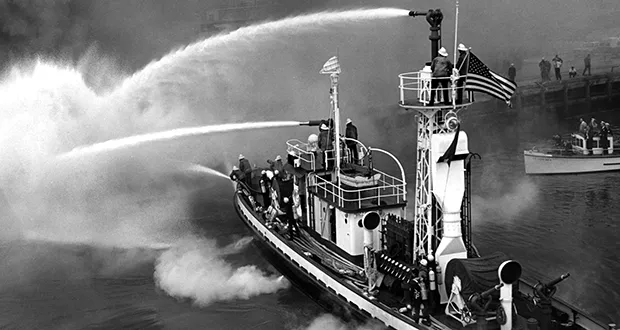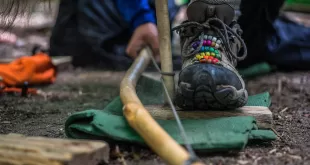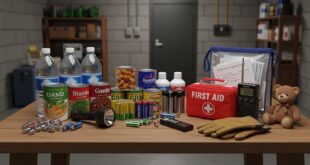The Test They Said Was Harmless
In the autumn of 1950 the U.S. Navy quietly parked ships in the San Francisco Bay and released a cloud of so called harmless microbes into the coastal air. The operation had a friendly code name that reads like the title of a travel brochure. Operation Sea Spray. The target was not an enemy military base. It was ordinary American neighborhoods. The goal was to see how a biological agent would drift, settle, and spread through a modern city wrapped in fog. The government did not bother asking the citizens for consent. It did not even tell them afterward. That truth only surfaced decades later when hearings and declassifications peeled back the curtain. You can read a straightforward overview of the test here in the summary on Operation Sea Spray and then compare it with the historical analysis of open air trials compiled for public health journals such as this review on open air biowarfare testing.
The Navy used Serratia marcescens and Bacillus globigii as simulants because they were cheap to grow and easy to track in samples. At the time, officials claimed these organisms were benign. Later clinical literature documented real infections tied to Serratia and described how cavalier those assumptions were. If you want the medical side without politics, look at the New England Journal of Medicine’s historical review of Serratia marcescens outbreaks and a broader clinical survey that walks through the organism’s disease profile in detail here in the National Library of Medicine’s collection on Serratia infections.

For anyone serious about disaster preparedness, this is a wake-up call. The very agencies sworn to protect the public can — and have — exposed citizens to dangerous situations without warning. A biological hazard doesn’t have to come from an enemy nation or a terrorist group. It can come from your own government, in the name of “research” or “testing.” This means that survival planning must cover more than storms, earthquakes, and grid failures. You must also be prepared for chemical or biological contamination events that may never be announced until it’s too late.
Illness, A Death, And A Lawsuit The Government Could Shrug Off
After the spray, San Francisco saw a cluster of unusual infections. One patient, Edward J. Nevin, developed a Serratia infection and died. His family later brought suit, only to run headlong into the legal shield that protects federal agencies when policy decisions go bad. The Wall Street Journal’s retrospective notes the family’s claim and the government’s immunity posture. For the preparedness-minded, this underscores an important point: you cannot rely on after-the-fact justice to undo damage from a disaster — especially when the source is the government itself.
Stanford clinicians documented an unusual run of Serratia cases soon after the San Francisco tests, which you can see referenced in NEJM’s historical notes. The National Library of Medicine collections add further detail, showing that what planners once called harmless was anything but harmless in the real world.
In a preparedness context, this teaches another vital lesson: early detection and independent verification of threats matter. In the 1950 incident, people didn’t even know they were in danger, and by the time illnesses surfaced, the event was over. For modern preppers, tools like HEPA air filtration, portable water filtration, and even home lab testing kits for basic contaminants can be a critical part of your setup — giving you a fighting chance to detect problems when official sources remain silent.
The Pattern Is The Problem
The San Francisco test was not a one-off mistake. Between 1949 and 1969, the U.S. military conducted 239 open-air biological tests in populated areas across the country. The PBS American Experience archive outlines how cities, subways, and military bases were exposed to secret releases. Government planners used Bacillus globigii as a stand-in for anthrax and other deadly agents, sometimes calculating “safe” exposure limits that treated human beings as data points rather than lives.

The National Security Archive holds declassified files showing how testing expanded after 1950, with sites like Dugway Proving Ground serving as major hubs for these experiments. The Defense Health Agency still hosts pages acknowledging Dugway’s role in chemical and biological testing.
For survivalists, the lesson is chilling but clear: never assume you’ll be warned about danger. Whether the threat is a natural pandemic, a toxic industrial accident, or a government test gone wrong, your survival depends on having your own protective measures ready to go. That means respirators, stored food and water, and a bug-out plan aren’t optional — they’re the baseline.
Preparedness Lessons From Operation Sea Spray
What does this Cold War incident teach us about readiness today?
- Expect the unexpected. Operation Sea Spray was not a response to an emergency — it was the emergency, created from within. Threats can be manufactured just as easily as they occur naturally.
- Redundancy saves lives. Have multiple ways to ensure clean air and water. Biological agents can spread through both.
- Independent information matters. Relying solely on official announcements can leave you blindsided. Alternative news, amateur radio networks, and citizen monitoring can be lifesaving.
- Drills aren’t just for fire. Practice shelter-in-place and decontamination routines before you need them.
- Medical preparedness is crucial. Stock basic protective gear, masks, gloves, and disinfectants that are effective against both viral and bacterial threats.
Why This Matters Now
This history matters every time an agency asks for more power or demands unquestioned compliance. The AJPH review by Leonard Cole makes clear that ethics changed only after public exposure — not before. Trust is earned, not automatic, and in preparedness terms, that means taking responsibility for your own safety and that of your family.
Preparedness is not about paranoia; it is about resilience. If a government can spray a city with bacteria and hide it for decades, you can’t afford to believe that “it would never happen here.” It already has. It will again. And when it does, your gear, your skills, and your plan will be the only things standing between your family and the consequences.
 Survive Our Collapse Building Self-Reliance in an Uncertain World
Survive Our Collapse Building Self-Reliance in an Uncertain World




